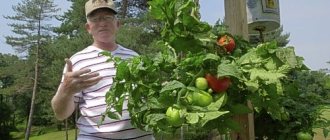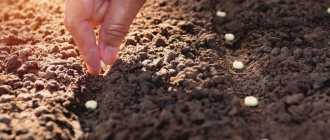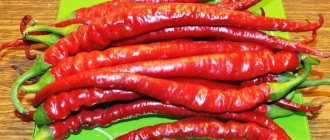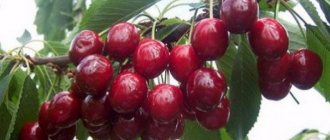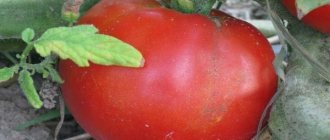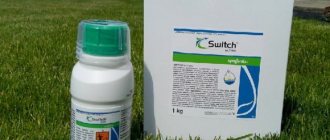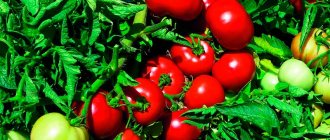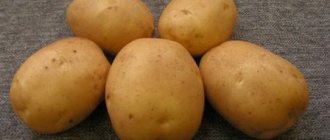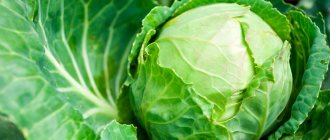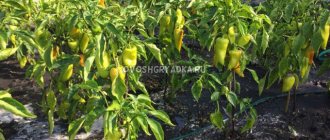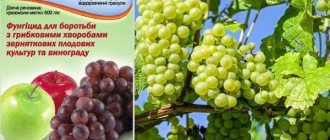Vegetable growing » Tomatoes
1
6571
Article rating
Kira Stoletova
In order for tomatoes in the garden to grow healthy and actively bear fruit, it is important to provide them with proper care. One of the main measures is treating plants with fungicides. Most often, Bordeaux mixture is used for tomatoes.
Bordeaux mixture for processing tomatoes
This drug has a wide spectrum of action. It is used to control pests and diseases. In order for Bordeaux mixture to bring the desired effect, it is important to understand how to prepare the solution and process the culture.
The history of Bordeaux mixture
Invented in France by the chemist Joseph Louis Proust, a mixture of lime and copper sulfate protected plants (mainly grapes), but not from mushrooms, but from ordinary thieves who stole crops from other people's vineyards.
The bunches of grapes, poured with a blue liquid, looked corroded by mold and did not evoke a desire to eat them. After harvesting, the mixture was easily washed off and the grapes took on a marketable appearance.
Only sixty years after the death of Joseph Louis Proust, the famous botanist Pierre Marie Millardet noticed that there was no grape rot on grapevines treated with a solution of lime and copper sulfate. Thus began the use of Proust's mixture or Bordeaux mixture to combat fungal diseases not only of grapes, but also of many other fruit and vegetable crops.
Flow calculation
For any vegetable crop, including tomatoes, there is its own optimal dosage of the drug, which is supposed to be used to treat the beds or garden plot:
- if you plan to use the solution to protect young fruit trees, then you will need at least 2 liters per tree;
- to process crops that are actively bearing fruit, you will have to use at least 10 liters of liquid;
- if you need to spray bushes, be prepared to spend at least 1.5 liters of solution per bush;
- To spray a tomato, you need to prepare 2 liters of liquid per 10 square meters. m beds.
When to use Bordeaux mixture
The most common and favorite crop of summer residents are tomatoes.
Tomatoes are one of the vegetable crops prone to fungal damage. It is important not to miss the moment when you need to spray tomatoes with Bordeaux mixture, otherwise you may lose the entire harvest.
The most dangerous fungal diseases of tomatoes are late blight, streak and brown spot.
Late blight
Late blight causes late blight, a plant disease to which members of the Solanaceae family are most susceptible.
Signs of late blight:
- Weeping dark spots appear on one side of the leaves, becoming darker in color over time;
- a fluffy white coating appears on the back side of the leaf plate;
- after some time, the tomato leaves completely dry out;
- the fruits of an infected plant become red-brown and unsuitable for use in cooking and preparations.
In case of late blight, you should immediately apply Bordeaux mixture for tomatoes so that the disease does not spread to the rest of the seedlings.
Streak
Viral infection of tomatoes.
Evidence of virus penetration:
- ground elements of plants are covered with red-brown streaks;
- stems become fragile and lag behind in development;
- stripes of yellow or brown color appear on ripened fruits;
- the shape of the fruits is distorted, they begin to rot right on the branches and emit a sharp, unpleasant odor.
Brown spot (cladosporiosis)
The disease affects the leaves of tomatoes growing both in greenhouses and in open soil.
Symptoms of cladosporiosis:
- the lower tomato leaves on the outside are covered with light green spots; when examining the inside, you can see a light gray coating;
- Subsequently, the color of the plaque becomes brown, and the fungus infects the entire tomato bush.
Where to get ingredients for making fungicide
The main ingredients for preparing Bordeaux mixture are copper sulfate and quickliquid, which are sold in stores or departments specially designed for gardeners.
The substances are sold in small sealed plastic bags. When purchasing, you need to take a closer look at the expiration date of the composition, as well as the storage conditions of the packages.
Characteristics of tomato varietiesThe most delicious varieties of tomatoes
- Caring for tomatoes during flowering - proper planting, feeding and fertilizing tomatoes (105 photos)
Quicklime is stored in dried, low-moisture rooms, and copper sulfate is stored in cold warehouses protected from sunlight.
Tips and tricks
If you don’t want to prepare the liquid yourself, purchase the dry mixture at a specialty store and simply dilute it with water. In the concentrate format, the mixture is more convenient, but also costs an order of magnitude more.
If Bordeaux mixture enters the body, coughing, sneezing, weakness, and chills may occur. In this case, call an ambulance immediately; do not hope that the side effects will go away on their own.
If the drug gets into the respiratory tract, take diuretics or antipyretics. In case of contact with skin, rinse thoroughly with plenty of water. And if the liquid gets into the gastrointestinal tract, but gastric lavage and activated charcoal are required.
Important ! In addition to tomatoes, flower, berry, fruit bushes and trees are treated with liquid.
Preparatory work
To dilute Bordeaux mixture for spraying tomatoes, you need to prepare in advance:
- gauze piece;
- five-liter and ten-liter container;
- not a rusty nail, metal knife or litmus paper;
- sieve
- wooden stick.
Important: vessels for preparing the fungicidal mixture must be made of plastic, glass, clay or wood. When using old enamel pots or buckets, check that they are not chipped. Products made of iron, aluminum, as well as galvanized utensils are not suitable for preparing the suspension.
Bordeaux mixture can be used in 1% or 3% concentration.
A three percent solution is used for spraying gardens in early spring, and a one percent solution is used during the growing season of plants.
Pink giant tomato - 115 photos, description and characteristics of the variety. Planting rules and variety yieldTomato Andromeda - description of the variety and its characteristics. Varieties of tomato and tips for choosing planting material (90 photos)
How to fertilize tomatoes when planting: choosing fertilizers and applying fertilizer to the hole. Tips for planting tomatoes (85 photos + video)
To prepare 1% Bordeaux mixture for tomatoes, you need to take 100 grams of copper sulfate and 120 grams of quicklime; to prepare a 3% suspension of components, you need to take three times as much.
Procedure for preparing the mixture
Pour 1 liter of hot water into a container and add copper sulfate powder. Stirring constantly, add 4 liters of cold water.
To prepare lime milk, take another container and quench the lime in a liter of hot water. Add 4-4.5 liters of cool water to the solution.
Filter both solutions through gauze placed on a sieve.
Pour copper sulfate into the milk of lime, constantly stirring the resulting solution with a wooden stick.
What kind of soil do tomatoes like - the optimal composition of the soil for planting tomatoes and its characteristics + 100 photosIs it necessary to plant cherry tomatoes - forming and growing mini tomatoes in open ground, in greenhouses and greenhouses (120 photos and videos)
Tomato varieties for open ground: the best productive varieties. 125 photo and video recommendations from experts
Pack the container with the solution hermetically to protect it from contact with air.
Important: If you pour milk of lime into a solution of copper sulfate, you will get a less stable suspension that will quickly precipitate. It will weakly adhere to the foliage, and its use will not bring the desired effect.
Using ready-made Bordeaux mixture in bottles
A ready-made solution of Bordeaux mixture has gained popularity among gardeners. According to the instructions on the bottle, water is mixed with liquid in the required proportions. For example, to obtain a 1% liquid, combine 100 ml of water and 100 ml of Bordeaux mixture.
This solution also has a preventive and therapeutic effect on tomatoes. It is easy to use; you do not need to waste time and effort preparing the drug yourself.
The plant is sprayed in spring or autumn. Operations are performed carefully, strictly according to the recommendations on the bottle. The slightest inaccuracies can damage the tomatoes and cause burns on the bushes.
What does a solution look like when prepared according to all the rules?
The solution should be opaque, with a blue tint and have a neutral reaction to acidity indicators.
To check the reaction, you need to immerse a metal object in the suspension - the metal will turn red copper. If you are a more advanced gardener, add a litmus leaf to the composition. The color of the paper will change from blue to red.
Excess copper sulfate will give the prepared emulsion an acidic reaction and a greenish color. An acidic Bordeaux mixture will burn the leaf blade and the fruit of the plant; in the future, the green mass will crumble and the fruit will be covered with a net.
How and when to spray tomatoes and other vegetable and fruit crops
To treat tomatoes with Bordeaux mixture, it is preferable to purchase a garden sprinkler with a fine tip. Spraying is carried out 2-4 times a season, the interval between pollination should be at least 10 days to avoid the accumulation of copper in the ground. The last time to process trees or beds is 15 days before harvest.
When spraying, you should use a freshly prepared suspension; the procedure is best done with the first rays of the sun or after sunset to avoid burns on the leaves. Heavy dew, windy and pre-rainy weather will create unfavorable factors for plant treatment.
Bordeaux mixture is used to prevent and treat cucumbers from penosporosis (downy mildew).
Grapes should be sprayed with 3% Bordeaux mixture twice a year - in the spring and in the autumn after harvest. Before the shoots open, it is necessary to treat the vine to create a protective barrier against harmful spores and microorganisms.
Further treatment should be carried out with a 1% solution. After autumn pruning, the grapevine must be doused again with 3% liquid. In total, Bordeaux mixture can be used in the vineyard at least six times per season.
Tomato processing
The drug is used for spraying vegetables - tomatoes, cucumbers, eggplants, onions, potatoes - to treat late blight.
It's worth learning about tomatoes. When the first signs of the disease appear, they are sprayed with 0.5, 0.75 or 1% Bordeaux mixture.
Sprinkling is carried out 2-3 times per season with an interval of 10 days. But it is better not to process vegetables after the fruits appear, since spraying with this solution may cause fruits to fall off. For 10 m² of plantings, use 0.5-1 liters of solution.
More than 4 treatments per season cannot be carried out, since Bordeaux mixture is poisonous.
The leaves are treated evenly using a sprayer with a fine nozzle. Treatment cannot be carried out during the flowering period of tomatoes.
The last treatment is carried out 2-3 weeks before harvesting the fruits.
The drug is used for spraying vegetables - tomatoes, cucumbers, eggplants, onions, potatoes - for the treatment of late blight
Vegetables should be washed thoroughly before eating.
Treatment with Bordeaux mixture is not carried out during strong winds, heavy dew, or before rain.
You cannot add water to an already prepared solution or add dry vitriol powder to diluted lime; this will cause the mixture to crystallize and will be quickly washed off the plants by rain. There is no need to add soap to the mixture for good adhesion.
Pros and cons of using Bordeaux mixture
The advantages include the following factors:
- long-term effectiveness (protects the plant from fungal diseases for a month);
- affects a wide range of fungi and viruses that attack vegetables and fruit trees;
- resistant to negative atmospheric conditions (rain);
- affordable;
- made at home.
Flaws:
- short shelf life;
- the possibility of damaging the plant by not observing the proportions during the preparation of the solution or by improper processing;
- toxic to humans and animals.
How to protect yourself when working with the compound
- It is forbidden to mix dry copper sulfate with lime;
- the temperature of the substances during mixing should be the same and cold;
- Spray plants while wearing a medical mask or respirator;
- Upon completion of preventive work, wash your face and hands with laundry soap.
If signs of chemical poisoning appear, such as nausea, vomiting, dizziness, bloating, the stomach should be rinsed with boiled water and contact the nearest medical facility.
